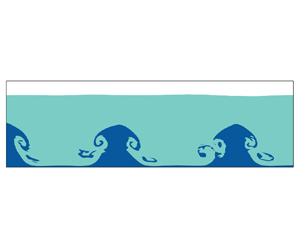Article contents
Interface instabilities in Faraday waves of two-layer liquids with free surface
Published online by Cambridge University Press: 03 May 2022
Abstract

For a fluid system with an interface between two-layer liquids and a free surface, there exist two series of natural frequencies. Under vertical excitations, the interface and the free surface can be excited separately or simultaneously. Laboratory experiments were conducted to excite the first- and second-mode Faraday waves on the free surface, which forced the in-phase motion of the interface. The experimental data were used to validate the extended numerical model NEWTANK. The secondary surface instability in the form of period tripling breaking occurred on the free surface when second-mode surface resonant response was large. Further numerical investigations were conducted to study the resonance of interface and in addition to the primary Faraday instability, the secondary interface instability occurred due to Rayleigh–Taylor (RT) instability. The analysis revealed that this was due to the contribution from the combined effects of vertical fluid acceleration and external excitation, which made the upper layer liquid essentially ‘heavier’ than the lower layer at certain instances, even when the amplitude of acceleration of the external excitation was lower than that of gravity at all times. A dimensionless parameter ‘normalised effective gravitational acceleration’ (NEGA) was proposed to quantify the occurrence criterion of RT instability in a dynamic fluid system. Furthermore, simultaneous resonances at both the interface and the free surface were studied and reverse flows could be formed across the interface as the upper Faraday waves and lower Faraday waves moved in opposite directions, which generated the secondary interface instability of Kelvin–Helmholtz (KH) type. When KH instability took place, more energy was transferred to higher frequency modes as time evolved.
JFM classification
Information
- Type
- JFM Papers
- Information
- Copyright
- © The Author(s), 2022. Published by Cambridge University Press
References
REFERENCES
- 31
- Cited by


